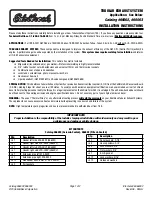
Driving in Water
Heavy rain can mean flash flooding, and flood waters
demand extreme caution.
Find out how deep the water is before you drive through
it. If it is deep enough to cover your wheel hubs,
axles or exhaust pipe, do not try it — you probably will
not get through. Also, water that deep can damage
your axle and other vehicle parts.
If the water is not too deep, drive slowly through it. At
faster speeds, water splashes on your ignition
system and your vehicle can stall. Stalling can also
occur if you get your tailpipe under water. And, as long
as your tailpipe is under water, you will never be
able to start your engine. When you go through water,
remember that when your brakes get wet, it may
take you longer to stop.
{
CAUTION:
Driving through rushing water can be
dangerous. Deep water can sweep your vehicle
downstream and you and your passengers
could drown. If it is only shallow water, it can
still wash away the ground from under your
tires, and you could lose traction and roll the
vehicle over. Do not drive through rushing
water.
See
Driving in Rain and on Wet Roads on page 4-39 for
more information on driving through water.
4-36
Summary of Contents for 2003 Yukon XL
Page 5: ...These are some examples of vehicle symbols you may find on your vehicle v ...
Page 6: ...Model Reference This manual covers these models Yukon Yukon XL vi ...
Page 64: ...Tahoe Yukon Second Row Seat Third Row 50 50 Split Bench Seat 1 58 ...
Page 94: ... NOTES 1 88 ...
Page 157: ... NOTES 3 3 ...
Page 158: ...Instrument Panel Overview 3 4 ...
Page 282: ... NOTES 3 128 ...
Page 372: ...When you open the hood on the VORTEC 8100 V8 engine you ll see the following 5 14 ...
Page 460: ...See Engine Compartment Overview on page 5 12 for more information on its location 5 102 ...
Page 488: ...Maintenance Record cont d Date Odometer Reading Serviced By Maintenance Record 6 20 ...
Page 500: ... NOTES 7 12 ...
















































